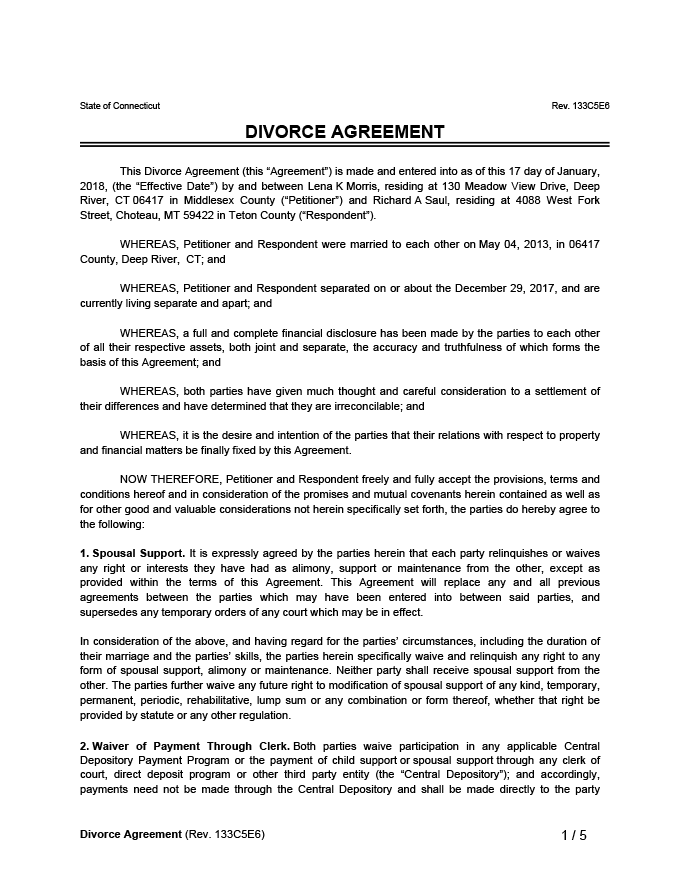
1. What is a written divorce form and Divorce Settlement Agreement?
A divorce settlement agreement is a written document between separating spouses that describes in detail all of the agreements between the two parties regarding the division of property, assets, debts, and liabilities. Agreement regarding custody, care and support for children, if any. , when their divorce became final.
2.Sample Divorce Settlement Agreement
Below is a screenshot of the beginning of an example of a typical divorce settlement agreement.

3. How to write a Divorce Settlement Agreement
Step 1 – Provide information about the party and wedding
The first part of the divorce settlement agreement should contain detailed information about both parties and their marriage. Information about applicants and respondents The plaintiff is a husband and wife who have filed for divorce. The defendant is the spouse who is served with divorce papers. You must include contact information for both the plaintiff and defendant. Each party must indicate whether it is a member of the United States armed forces. If you are a member of the United States Army, Marine Corps, Navy, Air Force, or Coast Guard, you are protected by the Veterans Spouses Act (USFSPA). USFSPA describes how pensions, administration, exchanges, and health benefits are administered. It also provides advice on issues such as child and spousal support. The court will consider whether the spouse is a member of the armed forces to decide whether the settlement is fair. Old name If any party wishes to restore its former name or maiden name, it may request this in this Agreement. Wedding date and location You need to clearly determine the time and place where you and your husband will get married. Current status For no-fault divorces, some states require that the parties be “separated” for a certain period of time before the divorce is finalized. Setting a separation date in the agreement can help establish this time frame if necessary. Remember that living “separately” does not necessarily mean that the parties must live in different locations. At a minimum, this means they cannot be physically intimate. Often one spouse is at a financial disadvantage in the relationship and therefore cannot always live apart until the divorce is finalized.
Step 2 – Provide spousal support information
Spousal support, or alimony, is a payment from one spouse to another after separation or divorce. Spousal support allows the recipient spouse to maintain the standard of living they had during the marriage. Specify which party will receive spousal support, the amount, and the start and end dates of payments, if they are variable. If one spouse must pay alimony, they will often purchase a life insurance policy to ensure payment in the event of death. The supporting spouse will be considered the beneficiary and the supporting spouse will typically be required to maintain the insurance policy for the duration of the spouse's claim.
Step 3 – Add children's information
State clearly whether the parties have children under 18 years old or are expecting children. You must also include custody agreements between the parents: Exclusive legal and physical custody of the children Joint legal custody and primary custody The children's legal and physical custody are shared Sole legal custody and joint custody Legal custody determines which parent has the right to make decisions regarding the child(ren)'s upbringing, such as medical care, education, and religion. If one parent has sole legal custody, they can make unilateral decisions regarding the child(ren) without consulting the other parent. Unless one parent is found to be incompetent or incapable or it is impractical, the court will not award sole legal custody to one parent. Physical custody determines which parent(s) the child(ren) will live with. The custodial parent will provide day-to-day care. Primary custody means that one parent will have custody of the child(ren) most of the time. This parent is called the “custodial parent.” The “non-custodial parent” is granted visitation rights to spend regular time with the child(ren). If parents share custody, they will arrange a schedule to share the child(ren) 50/50 or as close as possible. Remember that certain custody arrangements have tax implications. For example, if custody is shared between a parent, they must decide which of them can claim the minor child on their tax return.
Step 4 – Agree to organize the tour
Visitation gives the noncustodial parent the right to visit their child(ren) on a regular basis. The non-custodial parent will have regular visitation rights if the parents share custody. Even if one parent has sole custody, the non-custodial parent will still receive regular visitation unless extenuating circumstances exist. Tour times may include weekday evening tours, certain weekend times, and/or certain holidays and celebrations.
Step 5 – Decide on expenses for your children Children's health insurance
You should discuss with your spouse which of you will be responsible for your child's health insurance and how to pay for medical expenses not covered by insurance. Child support Child support is a monthly payment made by one spouse to the other spouse to cover the financial needs of any children they may have. Both parents must support these children and the court can order either parent to pay child support. Every state has child support guidelines that help determine the amount a spouse must pay. Child support amounts based on these guidelines help the court determine whether the amount is fair. Although the parties are not required to use the guidelines, if the court is asked to approve the agreement, it may ask on what basis the amount is determined. Classes for children You can include provisions for your child's tuition. You can designate who will be responsible for paying your tuition and fees at the private school or college. Specific rights and responsibilities Special rights and responsibilities are agreements between parents regarding custody of the child(ren) and any actions taken (or not taken) while the child(ren) are in the care of the other parent. take care of. . For example, you can specify that neither parent is allowed to encourage their child to call another person "Mom" or "Dad" in the event of a divorce.
Step 6 – Add property information Landing
This part is associated with the marital home. The marital home is the house where husband and wife live together when they are newly married. When a couple separates, they will have to decide what to do with their marital home. The parties may agree that: One of the parties will retain the marital home and will be its sole owner. They will sell the house and share the profits They will continue to own the marital home and one of the parties will continue to reside there. Personal property Small items such as tables, chairs, tables, chairs, pots, pans, and dishes are often shared in advance between the parties and mentioned in the agreement. These are usually items of small value. However, larger and more valuable personal assets may be divided as part of the settlement. Objects such as a painting, crystal chandelier, vintage dining table or other valuable items that may be a source of conflict between the parties or important to one spouse may be subject to a settlement agreement. sounds and are divided into chords. Mean of transportation If the parties jointly own the vehicle, they must decide how to divide the vehicle in the event of divorce and how to pay for the vehicle documents, if any.
Step 7 – Provide debt, account and tax information
Bank accounts and finances If you and your spouse share a bank account, you must fill in the account information here. A joint bank account is a checking account, savings account, money market account, certificate of deposit, or other account opened at a financial institution in both parties' names. The parties will need to decide how they want to divide the joint bank account. Outstanding debts, expense accounts, and credits Agree with your spouse who will be responsible for any outstanding joint debts and provide details of the debt in the document. Pension and retirement accounts Spouses may also be entitled to a portion of the other spouse's pension and/or retirement plan, which are accounts established or currently open to replace income in retirement. If money is paid into the account while the couple is married, the money can be considered part of the marital assets. Examples of such plans include individual retirement plans (IRAs), 401(k)s, and profit-sharing plans. Decide whether you or your spouse will split profits between the pension and retirement accounts and provide details of the retirement accounts of the parties involved. Income Tax When it comes to income taxes, you and your spouse need to decide when you will both start filing your individual tax returns. This could happen at the beginning of a certain year or when the divorce decree becomes final. Also, discuss who will be responsible for any omissions in the previous joint tax return.
Step 8 – Add final details
Free payment through sales staff In some states, spousal support is paid by default through a central deposit payment program or court clerk, direct deposit program, or other third party. Such a system allows the court to ensure that payments are made. The parties may waive their right to make payments through the central custody settlement scheme and instead agree to pay each other directly. Additional regulations This section allows you to add additional terms to the agreement that were not mentioned in the previous sections. The recognition of witnesses and notaries You don't need witnesses to sign the agreement. However, having a witness sign the agreement will help prove its authenticity, in case of doubt. Be sure to check your state laws regarding witness requirements. You should have the agreement notarized by a notary public. Deposits The divorce agreement is filed with the court and the court must approve it before issuing the final divorce decree. This agreement is often included in the final divorce decree, where it can be enforced by the court. If you do not include it in your final divorce decree, this agreement is just like any other legal agreement between you and the other party and is equally enforceable. A divorce settlement agreement filed with the court is often called a marital settlement agreement. Finally, add the agreement date; You have finished drafting the divorce settlement agreement.
4. Tips for Writing a Divorce Settlement Agreement
Consider using a mediator
When drafting your divorce settlement agreement, consider whether mediation is the right option for you. Discussing issues with an impartial third party can help resolve them more quickly, and you can prevent the divorce process from dragging out in court. Additionally, depending on your child's age, mediation may help your child have a say in the custody arrangement. Talking frankly with their parents may be too difficult for them. Using a mediator can provide more honest answers and ultimately help you reach an agreement that satisfies the entire family.
Full disclosure of all information
When drafting a divorce settlement agreement, it is essential to list all assets (including gifts, inheritances, and real estate). Failure to disclose all of your assets could lead to future litigation in which you may be fined and may transfer ownership of assets to your spouse as a penalty. Consider that some states follow community property laws while others are completely segregated property states. Before drafting joint divorce papers, consider consulting with a qualified legal professional to ensure you are in compliance with state laws regarding divorce.
Q&A
Question 1: What is a divorce settlement agreement?
Answer 1: A divorce settlement agreement, often referred to as a marital settlement agreement or divorce decree, is a legally binding document that outlines the terms and conditions of a divorce. It covers various aspects of the divorce, including property division, alimony, child custody, child support, visitation, and any other relevant matters.
Question 2: What key elements are typically included in a divorce settlement agreement?
Answer 2: A divorce settlement agreement usually includes provisions regarding the division of marital assets and debts, spousal support (alimony), child custody arrangements, visitation schedules, child support payments, and any special provisions or agreements made by the divorcing spouses.
Question 3: How is a divorce settlement agreement created and finalized?
Answer 3: A divorce settlement agreement is typically negotiated between the divorcing spouses and their respective attorneys. Once both parties reach an agreement on all relevant issues, the document is drafted and reviewed by legal counsel. It is then submitted to the court for approval. Once approved by the court, it becomes a legally binding contract.
Question 4: What role does a divorce settlement agreement play in the divorce process?
Answer 4: The divorce settlement agreement serves as a crucial document in the divorce process. It outlines the terms agreed upon by the parties, reducing the need for litigation. It provides clarity on the division of assets, financial obligations, and child-related matters, helping to facilitate a smoother and more predictable divorce proceeding
Nội dung bài viết:






Bình luận